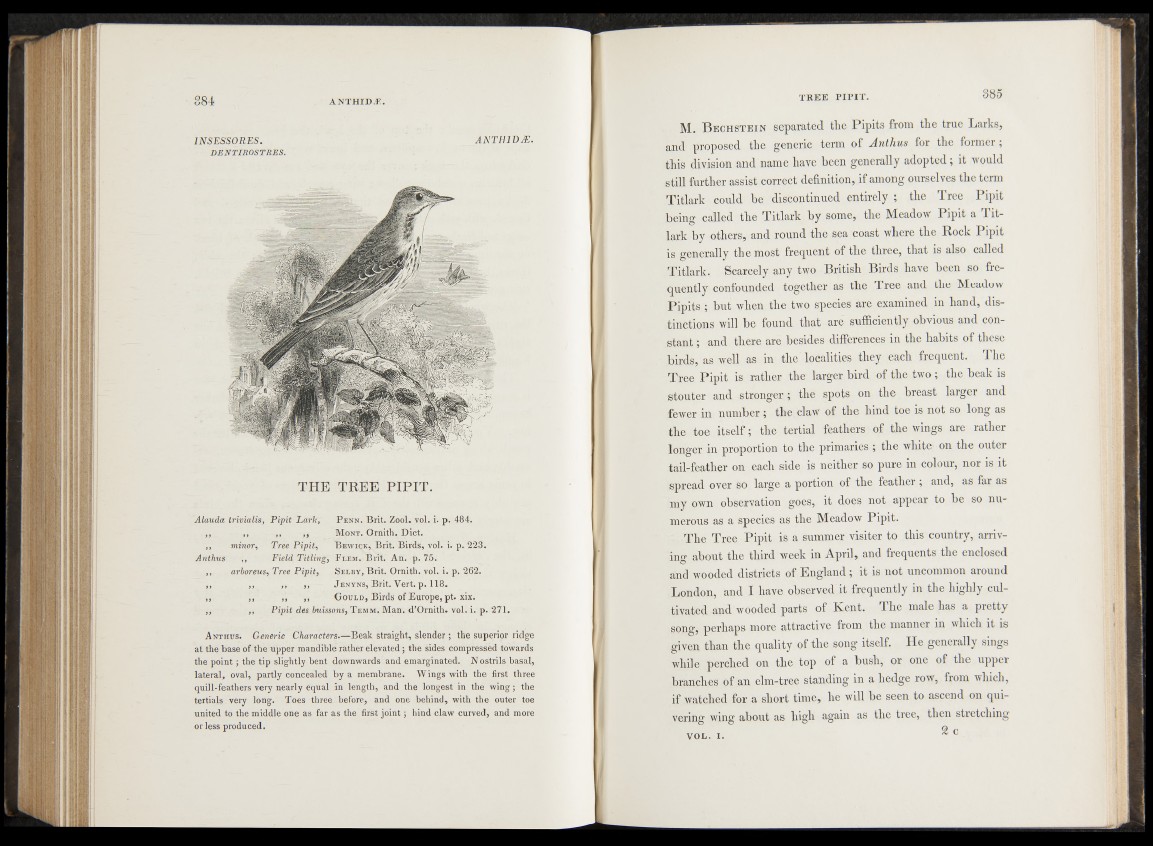
INSESSORES. ANTHIDJE.
TH E T R E E P IP IT .
DENTIROSTRES.
Alauda Irivialis, Pipit Lark, P enn. Brit. Zool. vol. i. p. 484.
,, ,, ,, ,, Mont. Ornith. Diet.
,, minor, Tree Pipit, B ewick, Brit. Birds, vol. i. p. 223.
Anthus ,, Field Titling, F lem. Brit. An. p. 75.
,, arboreus, Tree Pipit, Selby, Brit. Ornith. vol. i. p. 262.
,, ,, ,, ,, J enyns, Brit. Vert. p. 118.
,, ,, ,, ,, Gould, Birds of Europe, pt. xix.
,, ,, Pipit des buissons, T emm. Man. d’Ornith. vol. i. p. 271.
A nthus. Generic Characters.—Beak straight, slender ; the superior ridge
at the base of the upper mandible rather elevated; the sides compressed towards
the point; the tip slightly bent downwards and emarginated. N ostrils basal,
lateral, oval, partly concealed by a membrane. Wings with the first three
quill-feathers very nearly equal in length, and the longest in the wing; the
tertials very long. Toes three before, and one behind, with the outer toe
united to the middle one as far as the first jo in t; hind claw curved, and more
or less produced.
M. B echstein separated the Pipits from the true Larks,
and proposed the generic term of Anthus for the former;
this division and name have been generally adopted; it would
still further assist correct definition, if among ourselves the term
Titlark could be discontinued entirely ; the Tree Pipit
beintOr called the Titlark by" some, the Meadow Pipit a T. it#-
lark by others, and round the sea coast where the Rock Pipit
is generally the most frequent of the three, that is also called
Titlark. Scarcely any two British Birds have been so frequently
confounded together as the Tree and the Meadow
Pipits ; but when the two species are examined in hand, distinctions
will be found that are sufficiently obvious and constant
; and there are besides differences in the habits of these
birds, as well as in the localities they each frequent. The
Tree Pipit is rather the larger bird of the two; the beak is
stouter and stronger ; the spots on the breast larger and
fewer in number; the claw of the hind toe is not so long as
the toe itself; the tertial feathers of the wings are rather
longer in proportion to the primaries ; the white on the outer
tail-feather on each side is neither so pure in colour, nor is it
spread over so large a portion of the feather , and, as far as
my own observation goes, it does not appear to be so numerous
as a species as the Meadow Pipit.
The Tree Pipit is a summer visiter to this country, arriving
about the third week in April, and frequents the enclosed
and wooded districts of England; it is not uncommon around
London, and I have observed it frequently in the highly cultivated
and wooded parts of Kent. The male has a pretty
song, perhaps more attractive from the manner in which it is
given than the quality of the song itself. He generally sings
while perched on the top of a bush, or one of the upper
branches of an elm-tree standing in a hedge row, from which,
if watched for a short time, he will be seen to ascend on quivering
wing about as high again as the tree, then stretching
VOL. I. 2 c